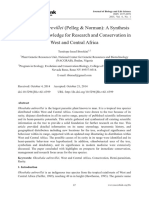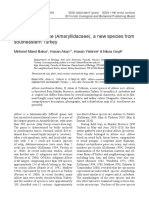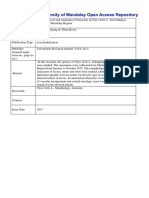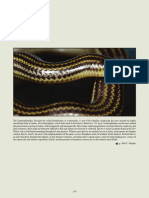Professional Documents
Culture Documents
Eupatorium Leonardii - Brittonia 2012
Uploaded by
Richelle FigueroaOriginal Title
Copyright
Available Formats
Share this document
Did you find this document useful?
Is this content inappropriate?
Report this DocumentCopyright:
Available Formats
Eupatorium Leonardii - Brittonia 2012
Uploaded by
Richelle FigueroaCopyright:
Available Formats
!"#$%"&'$()$&"*+"!"#$%&'(")",!&-$./($/$0 +.
*1"-2$"32)4)'')#$&
!"#$%!&'()*+,-%.%/012232%4&'43""3")2
!"#$$%&#' ! "##$!%%%&'()*+ ,-./01!*2 $/0314!2 ! 54677-869!:;%(;<!*2=>*?'>&> @A"!(%B(%%&CD(;;;?'%(;');2)'E
1 23
Your article is protected by copyright and all rights are held exclusively by The New York Botanical Garden. This e-offprint is for personal use only and shall not be selfarchived in electronic repositories. If you wish to self-archive your work, please use the accepted authors version for posting to your own website or your institutions repository. You may further deposit the accepted authors version on a funders repository at a funders request, provided it is not made publicly available until 12 months after publication.
1 23
Author's personal copy
A new species of Eupatorium (Asteraceae) from the Philippines
ERIC E. LAMONT1
1 2
AND
ULYSSES F. FERRERAS2
The New York Botanical Garden, Bronx, NY 10458-5126, USA; e-mail: elamont@optonline.net Herbarium, Institute of Biology, University of the Philippines, Diliman, 1101, Philippines; e-mail: uferreras@yahoo.com
Abstract. Eupatorium leonardii, presently known only from Mt. Mingan in the border region between Aurora and Nueva Ecija Provinces in Luzon, Philippines, is described and illustrated. The new species is remarkable because it is the only woody representative of the genus with a peculiar spiral phyllotaxy. Previously, Eupatorium s. str. consisted of herbs with opposite or verticillate phyllotaxy. Key Words: Eupatorium, Asteraceae, Philippines Flora, new species.
Eupatorium L. was once a large, articial genus of approximately 1200 species, but is now split up into numerous segregate genera (King & Robinson, 1987; Funk et al., 2009). As currently circumscribed, Eupatorium is composed of 48 species of annual or perennial herbs from eastern North America, the West Indies in Cuba, south and east Asia, with one species (E. cannabinum L.) reaching North Africa and Europe (Bremer, 1994). Phylogenetic analyses of DNA sequences done by Schilling et al. (1999), Schmidt and Schilling (2000), and Ito et al. (2000a, b) have provided insight into phylogenetic relationships among Eupatorieae genera and within sections of New World Eupatorium, but no sequence data has been published on any Eupatorium species from the Philippines. In the Philippines, no systematic study of Eupatorium has been conducted, nor has a complete ora been published. Historically, eight species of Eupatorium have been reported from the Philippines: E. benguetense C. Robinson, E. camiguinense Merr., E. cannabinum L. ssp. asiaticum Kitam., E. catense Elmer, E. lindleyanum DC., E. nodiorum Wall., E. sambucifolium Elmer, and E. toppingianum Elmer. However, the taxonomic status and distribution of these species have not been recently studied. Elmer (1906, 1915) considered E. toppingianum closely related to E. sambucifolium and noted that E. catense was similar to but distinct from
Eupatorium sambucifolium Elm. of northern Luzon. Robinson (1908) noted morphological similarities between E. sambucifolium and E. benguetense. Koster (1935) listed E. sambucifolium and E. benguetense as synonyms of E. toppingianum, but King and Robinson (1987) and H. Robinson (2011, pers. comm.) recognized all three taxa as distinct species. Merrill (1912) considered E. camiguinense manifestly allied to Eupatorium sambucifolium Elm., E. toppingianum Elm., and E. benguetense C. B. Rob., and nearer the rst than to either of the others. Currently, Eupatorium catense is usually listed as a synonym of E. camiguinense, while E. benguetense, E. camiguinense, and E. sambucifolium are considered endemic to the Philippines (King & Robinson, 1987). The native status of E. cannabinum ssp. asiaticum in the Philippines is debatable. Merrill (1912) reported a distinct northern type of E. japonicum sensu Merr. non Thunb. [=E. cannabinum ssp. asiaticum] in the Philippine ora and Ferreras (pers. obs.) reported it as established in the Philippines, but King and Robinson (1987) did not include the Philippines within the native range of E. cannabinum. Koster (1935) reported E. nodiorum from the Philippines, but we have not seen any specimens to verify this report. While conducting oristic research on remote Mount Mingan in 2006, Ferreras
ISSUED: 1 December 2012
Brittonia, 64(4), 2012, pp. 368373 2012, by The New York Botanical Garden Press, Bronx, NY 10458-5126 U.S.A.
Author's personal copy
2012]
LAMONT & FERRERAS: EUPATORIUM (ASTERACEAE)
369
located a small population of an unfamiliar species of Eupatorium. Plants were photographed and ve voucher specimens were collected and shown to Leonardo Co who suspected it was a new species. In 2011, Lamont examined vouchers and veried the new species. Eupatorium leonardii U. F. Ferreras & E. E. Lamont, sp. nov. Type: Philippines. Luzon Island, Aurora Province, Central Sierra Madre Mountains, Mt. Mingan, 1527.863 N, 12123.799E, 1700 m, 20 May 2006, U. Ferreras 426 (holotype: PNH; isotypes: US, NY, UC, PUH). (Figs. 1, 2) Dwarf shrub, to 45 cm tall. Stems erect, dark brown, branched, terete, shallowly ribbed when dried, densely leafy apically, leaess to sparsely leafy basally, tuberculate at the lower portion, densely pubescent apically; trichomes stiff, often contorted, dense, uniseriate, 0.51.3 mm long, multicellular with 48 cells, bulbose at base tapering to the pointed apex; leaf scars raised and prominent, triangular. Leaves spirally alternate, congested at apex of branches, sessile to short petiolate up to 1 mm long, aromatic with turpentine odor when crushed; blades lanceolate, mostly 1230 cm long, 0.2 0.5 cm wide, evergreen, coriaceous, pinnatinerved and strongly reticulate, base cuneate, apex acute, margins serrate, teeth obtuse, discolorous, adaxial surface dark green, weakly bullate when dried, with impressed veins, abaxial surface paler green, alveolate, both surfaces of older leaves glabrous, young leaves furfuraceous especially at the apex. Inorescence solitary at the apex of owering stems; peduncle 0.52.0 cm long, copiously covered with the same type of trichomes as on the stem, with foliose bracteoles smaller than the uppermost leaves. Capitula discoid, in at-topped or convex to rounded, compound, corymbiform arrays; involucre cylindric, 4.56.5 mm high, 1.52.5 mm wide; phyllaries 59, 2- or 3-seriate, pale pink to purple, imbricate, appressed, persistent, lamina glabrous, margin ciliate distally, entire proximally, outer phyllaries 0.72.5 mm long, ca. 1 mm wide, ovate to oblong-lanceolate, acuminate to acute, inner phyllaries 3.5
5.5 mm long, ca. 1.2 mm wide, lanceolate to linear-lanceolate, conspicuously mucronate to rarely acuminate, sometimes keeled when dried; receptacle at to slightly convex, epaleate; pedicel ca. 1 mm long, copiously covered with the same type of trichomes as on the peduncle. Florets (2) 3 (5) per head, pink to pale purple, perfect; corolla ca. 3.0 mm long, tubular, glabrous, punctate distally (with a few scattered punctations below to mid-throat), apical teeth 5, ca. 0.5 mm long, deltate, tips slightly incurved; stamens 5, anthers not exceeding the corolla; style ca. 5 mm long, exserted, branches ca. 2 mm long, liform, divergent when fresh, not spreading when dried, base hirsute, enlarged. Cypsela ca. 2 mm long, 5-ribbed, prismatic, brown, glabrous; pappus ca. 4 mm long, stramineous, bristles 2227, minutely antrorsely barbed, in 1 series, persistent. Distribution and ecology.Eupatorium leonardii is known only from the type locality. The population consists of two individuals growing close to each other and a third growing approximately 150200 m away. Ferreras initially suspected that additional individuals might occur along the sharp-crested ridge system in the upper montane cloud forests of Mount Mingan but after an extensive, one-month eld survey in 2006, and a second visit in 2010, no other individuals were located. The type locality contains several recently described, topotypic taxa including Mycaranthes leonardoi Ferreras & Suarez and Diplycosia bartolomei Ferreras & Argent, as well as the range-restricted Robiquetia enigma Ferreras & Suarez (Ferreras & Suarez, 2009; Ferreras & Argent, 2011). Eupatorium leonardii was observed growing in two types of habitats. The rst was a sun-exposed, relatively at site on a ridge crest leading to the summit of Mount Mingan. The dominant vegetation consisted of stunted and moss covered trees, including Leptospermum avescens Sm., Podocarpus sp., Ilex paucinervia Merr., Elaeocarpus parvilimbus Merr., Astronia quadrangulata Maxw., Myrsine sp., Loheria crassifolia (Merr.) Stone, Dacrycarpus sp., Camellia mollis (Merr.) H. T. Chang & S. X. Ren, and Cleyera japonica Thunb. The second site, supporting one individual, was located at the base of a sun-
Author's personal copy
370
BRITTONIA
[VOL 64
FIG. 1. Eupatorium leonardii. A. Habit. B. Sterile stem with spirally alternate leaves and detail of leaf tip. C. Inorescence. D. Capitulum, with detail of trichomes on pedicel. E. Phyllary. F. Floret, cypsela, and pappus with details of corolla lobes (left) and pappus bristle (right). G. Floret l.s., with detail of the enlarged and hirsute style base. (Drawn from the type collection.)
exposed rock outcrop in a thick mat of moss, humus, and soil immediately behind a dense thicket of Pandanus sp.
The rugged Mingan Mountains are part of a mountain complex extending along the middle segment of the Sierra Madre Moun-
Author's personal copy
2012]
LAMONT & FERRERAS: EUPATORIUM (ASTERACEAE)
371
FIG. 2. Eupatorium leonardii. A. Close-up of sterile stem with spirally alternate leaves congested at the apex of a branch. B. Inorescence; note the beetle (Family Chrysomelidae) on the right side.
tain Range which, with adjacent Aurora Memorial National Park on the west, forms an inverted triangular area of approximately 960 km2 (Co et al., 2007). The summit of Mount Mingan at 1905 m is the point of highest elevation in the Sierra Madre. Our current understanding of the ora of Mount Mingan and the immediate vicinity is based largely on the estimated total of 1200 to 1300 voucher specimens collected by R. Alvarez in 1910, M. Ramos and G. Edano in 1916, and M. Jacobs and D. Mendoza in 1968 (Co et al., 2007). An examination by Ferreras in 2010 of all Asteraceae exsiccatae deposited at the Philippine National Herbarium revealed no previous collections of E. leonardii from these earlier botanical expeditions. The prevailing climate in this region is classied as Type IV under the modied Corona Classication System where rainfall is more or less evenly distributed throughout the year. A PAG-ASA meteorological station in Baler, Aurora, 40 km northeast of Mount Mingan, recorded an average monthly rainfall of 457 mm (PAG-ASA-IRI-LDEO Climate
Library, 2011). Extreme rainfall events usually occur from October to December and coincide with the arrival of tropical depressions, cyclonic storms, and typhoons. Occasionally, at least once or twice every ten years, storms with gale force winds exceeding 200 kph hit Aurora Province causing massive landslides in and around the vicinity of Mount Mingan. Conservation status and threats.Based on the extreme rarity of this species at the type locality and considering parameters outlined in IUCN Categories and Criteria (IUCN, 2001), Eupatorium leonardii can be considered Critically Endangered: CR B1ab(i, ii, v), 2ab (i, ii, iii, V), Csa(i, ii). A new anthropomorphic threat to E. leonardii is posed by the increasing number of mountaineering enthusiasts who hike along ridge crest trails during attempts to scale the summit of Mount Mingan. Unrestricted access to upper montane cloud forests by mountain climbers has resulted in trampling of vegetation and extensive habitat damage in many forest sites throughout the Philippines (Ferreras, pers. obs.).
Author's personal copy
372
BRITTONIA
[VOL 64
Phenology.On the basis of two visits to Mount Mingan by Ferreras in 2006 and 2010, owers of Eupatorium leonardii begin to open in early May and full maturity is reached by mid-June. Etymology.The specic epithet honors Leonardo L. Co (19532010), a respected and revered botanist in the Philippines who dedicated his career studying Philippine plants at the remotest localities. He is best known for his untiring and unselsh mentoring of young Filipino botanists. Leonard died tragically after being shot by the Philippine Army while conducting eld work with coworkers in the forests of Leyte. Eupatorium leonardii differs sharply from all other species of the genus because of its woody habit and peculiar spiral phyllotaxy. Phylogenetic analysis of DNA sequences (Schilling et al., 1999) have shown that Eupatorium must be circumscribed much more narrowly than the traditional views of Bentham (1873), B. L. Robinson (1934), and others. As circumscribed by King and Robinson (1987), Bremer (1994), and Siripun and Schilling (2006), Eupatorium s. st. includes only herbaceous taxa with opposite or verticillate phyllotaxy. With the discovery of E. leonardii, the morphological boundaries of the genus must be expanded. Due to the uniqueness of this species, it is not possible to indicate close relationships among the other species of Eupatorium occurring in the Philippines or in the New World. Acknowledgments We are grateful to Conservation International Philippines for funding the 2006 expedition to the Sierra Madre, with special thanks to Mariano Roy Duya and Grace Rosell-Ambal; Victor Dacumos of the Nueva Ecija University of Science and Technology, for hospitality; the DENR Regional Ofce for granting Gratuitous & Transport Permits, with special thanks to Nestor Bartolome and Frank Dalin; Harold Robinson and Vicki Funk for discussions on the generic placement of this new species; Bobbi Angell for the excellent illustration; Carol Gracie for digitally formatting Figure 2; Scott Mori for discussion on the trichomes of E. leonardii;
and Edward Schilling and Harold Robinson for their reviews the manuscript. Literature Cited
Bentham, G. 1873. Compositae. Pp. 163533. In: G. Bentham & J. D. Hooker (eds.), Genera plantarum, vol. 2 (1). Lovell Reeve & Co., Williams & Norgate, London. Bremer, K. 1994. Asteraceae. Cladistics and classication. Timber Press, Portland, Oregon. Co, L. L., U. F. Ferreras, N. A. Bartolome & F. M. Dalin. 2007. The forest vegetation of Mingan Mountains. Unpublished report to Conservation International Philippines. Elmer, A. D. E. 1906. Manual of the Philippine Compositae. Leaets of Philippine Botany 1: 83186. . 1915. Two hundred twenty six new speciesI. Leaets of Philippine Botany 7: 25432700. Ferreras, U. F. & W. Suarez. 2009. Mycaranthes leonardoi and Robiquetia enigma: two new orchid species from the Philippines. Australian Orchid Review 74: 3739. & G. Argent. 2011. Diplycosia bartolomei (Ericaceae): a new species from the Philippines. Edinburgh Journal of Botany 68: 3338. Funk, V. A., A. Susanna, T. F. Stuessy & R. J. Bayer (eds.). 2009. Systematics, evolution, and biogeography of Compositae. International Association for Plant Taxonomy, Vienna, Austria. Ito, M., K. Watanabe, Y. Kitai, T. Kawahara, D. J. Crawford & T. Yahara. 2000a. Phylogeny and phytogeography of Eupatorium (Eupatorieae, Asteraceae): insights from sequence data of the nrDNA ITS regions and cpDNA RFLP. Journal of Plant Research 113: 7989. , T. Yahara, R. M. King, K. Watanabe, S. Oshita, J. Yokoyama & D. J. Crawford. 2000b. Molecular phylogeny of Eupatorieae (Asteraceae) estimated from cpDNA RFLP and its implication for the polyploidy origin hypothesis of the tribe. Journal of Plant Research 113: 9196. IUCN. 2001. The IUCN red list of threatened species. Categories & Criteria (version 3.1). Prepared by the IUCN Species Survival Commission. IUCN, Gland, Switzerland, and Cambridge, United Kingdom. King, R. M. & H. Robinson. 1987. The genera of the Eupatorieae (Asteraceae). Monographs in Systematic Botany from the Missouri Botanical Garden, vol. 22. Missouri Botanical Garden, St. Louis. Koster, J. T. 1935. The Compositae of the Malay Archipelago, I. Vernonieae and Eupatorieae. Blumea 1: 351536. Merrill, E. D. 1912. New or noteworthy Philippine plants, IX. Philippine Journal of Science 7: 259357. PAG-ASA-IRI-LDEO Climate Library. 2011. http:// iridl.ldeo.columbia.edu/SOURCES/.PAGASA/ .monthly/.station/index.html (accessed November, 2011). Robinson, B. L. 1934. Records preliminary to a general treatment of the Eupatorieae, XI. Contributions from the Gray Herbarium of Harvard University n.s. 104: 349. Robinson, C. B. 1908. Alabastra Philippinensia, II. Philippine Journal of Science 3: 175218.
Author's personal copy
2012]
LAMONT & FERRERAS: EUPATORIUM (ASTERACEAE)
373
Schilling, E. E., J. L. Panero & P. B. Cox. 1999. Chloroplast DNA restriction site data support a narrowed interpretation of Eupatorium (Asteraceae). Plant Systematics and Evolution 219: 209 223. Schmidt, G. T. & E. E. Schilling. 2000. Phylogeny and biogeography of Eupatorium (Asteraceae: Eupator-
ieae) based on nuclear ITS sequence data. American Journal of Botany 87: 716726. Siripun K. C. & E. E. Schilling. 2006. Eupatorium. Pp. 462474. In: Flora of North America Editorial Committee (eds.). Flora of North America North of Mexico, vol. 21, Magnoliophyta: Asteridae, part 8: Asteraceae, part 3. Oxford University Press, New York.
You might also like
- New Dipterocarp Species From The Philippines: Hermes G. Gutierrez, Justo P. Rojo and Domingo A. MadulidDocument12 pagesNew Dipterocarp Species From The Philippines: Hermes G. Gutierrez, Justo P. Rojo and Domingo A. MadulidHaven Antony PanotesNo ratings yet
- Mangrove Ag132e06Document58 pagesMangrove Ag132e06hanzo1260No ratings yet
- 21) Morphology and AnatomyDocument4 pages21) Morphology and AnatomyeczhilalcilogluNo ratings yet
- Exacum Idukkianum Published Oct 2016Document5 pagesExacum Idukkianum Published Oct 2016PERUMAL RAVICHANDRANNo ratings yet
- Chilquillo 2019Document6 pagesChilquillo 2019Edersin TorresNo ratings yet
- Essential Organic Chemistry Canadian 3rd Edition Bruice Test Bank 1Document36 pagesEssential Organic Chemistry Canadian 3rd Edition Bruice Test Bank 1jessicacollinsmddqgonxabjr100% (26)
- Cinchoneae), A New Species From The Sira Mountains, Eastern Andes of Central Peru, and The Identity of Ladenbergia AcutifoliaDocument8 pagesCinchoneae), A New Species From The Sira Mountains, Eastern Andes of Central Peru, and The Identity of Ladenbergia AcutifoliaEdersin TorresNo ratings yet
- Peristylus BalakrishnaniiDocument3 pagesPeristylus BalakrishnaniiSumathi RamamurthyNo ratings yet
- Ricardo Ambrósio Soares de Pontes: ResumoDocument5 pagesRicardo Ambrósio Soares de Pontes: ResumoRicardo PontesNo ratings yet
- Crasuláceas Del Centro de PerúDocument14 pagesCrasuláceas Del Centro de PerúAle Aguirre LopezNo ratings yet
- Monolophus AmplexicaulisDocument6 pagesMonolophus AmplexicaulisMatthew TNo ratings yet
- Factsheet - Eucalyptus CrebraDocument4 pagesFactsheet - Eucalyptus CrebraDoug MohrNo ratings yet
- Amorim 2004 Heteropterys AndersoniiDocument4 pagesAmorim 2004 Heteropterys AndersoniiRafael Felipe de AlmeidaNo ratings yet
- Common Forest Insect Pests: Agrilus PlanipennisDocument25 pagesCommon Forest Insect Pests: Agrilus PlanipennisJuneville Vincent AndoNo ratings yet
- The Genus Morinda (Rubiaceae) in ThailandDocument9 pagesThe Genus Morinda (Rubiaceae) in ThailandTasnuba JahanNo ratings yet
- Article: A New Tree Species of Schinopsis (Anacardiaceae) From Paraguay and BoliviaDocument7 pagesArticle: A New Tree Species of Schinopsis (Anacardiaceae) From Paraguay and BoliviaJuan Carlos CatariNo ratings yet
- Flora of China - Key To AnoectochilusDocument5 pagesFlora of China - Key To AnoectochilusfelinabrancaNo ratings yet
- Adinandra Hongiaoensis (Theaceae), A New Species From Lam Dong, VietnamDocument5 pagesAdinandra Hongiaoensis (Theaceae), A New Species From Lam Dong, VietnamPlant VietNo ratings yet
- Two New Species of Monolophus (Zingiberaceae) From India: SummaryDocument7 pagesTwo New Species of Monolophus (Zingiberaceae) From India: SummaryMatthew TNo ratings yet
- Claoxylon LangabiasaeDocument6 pagesClaoxylon LangabiasaeAdhy Widya SetiawanNo ratings yet
- Flora Europaea FormDocument1,342 pagesFlora Europaea FormCristina Cris100% (1)
- DK Pocket Nature - TreesDocument224 pagesDK Pocket Nature - TreesHexun88% (17)
- Espeletia RestrictaDocument7 pagesEspeletia RestrictaNatalia MontañoNo ratings yet
- Mendum 2004-AltDocument8 pagesMendum 2004-AltLuffy ZoroNo ratings yet
- 21-34 New Records of Ferns For AssamDocument14 pages21-34 New Records of Ferns For AssamSushil Kumar SinghNo ratings yet
- 10 1126@science Aao0398Document14 pages10 1126@science Aao0398Alexander DamiánNo ratings yet
- Papaver SchoenswetterDocument24 pagesPapaver SchoenswetterThomas HaberlerNo ratings yet
- Two New Species of Paphiopedilum (Orchidaceae: Cypripedioideae) Section Barbata From Sumatra, IndonesiaDocument11 pagesTwo New Species of Paphiopedilum (Orchidaceae: Cypripedioideae) Section Barbata From Sumatra, IndonesiaIsroi.comNo ratings yet
- Vanda Perplexa (Orchidaceae) : A New Species From The Lesser Sunda IslandsDocument4 pagesVanda Perplexa (Orchidaceae) : A New Species From The Lesser Sunda IslandspurnomoNo ratings yet
- Twonewspeciesof Polyspora Theaceaefrom Vietnamandnewcombinationsforsome AsianspeciesDocument9 pagesTwonewspeciesof Polyspora Theaceaefrom Vietnamandnewcombinationsforsome AsianspeciesVan-Duong DoNo ratings yet
- Instituto de Pesquisas Jardim Botânico Do Rio de Janeiro RodriguésiaDocument6 pagesInstituto de Pesquisas Jardim Botânico Do Rio de Janeiro RodriguésiaFrancione GomesNo ratings yet
- Morphological Studies On Three Amaranthus Species: Svetoslava Terzieva, Neli Grozeva, Katya VelichkovaDocument5 pagesMorphological Studies On Three Amaranthus Species: Svetoslava Terzieva, Neli Grozeva, Katya Velichkovaolajummy675No ratings yet
- Gatra Taksonomi Argostemma Wall. (Rubiaceae-Rubioidae) Di Gunung Gede-Pangrango, Gunung Halimun, Dan Gunung Salak Berdasarkan Karakter MorfologiDocument6 pagesGatra Taksonomi Argostemma Wall. (Rubiaceae-Rubioidae) Di Gunung Gede-Pangrango, Gunung Halimun, Dan Gunung Salak Berdasarkan Karakter MorfologiTropisland Roots WearNo ratings yet
- Flora EuropaeaDocument1,344 pagesFlora EuropaeaokrimUb67% (3)
- Mcdonald1990 CHANGES AND ADDITIONS IN IPOMOEA SECTION BATATASDocument5 pagesMcdonald1990 CHANGES AND ADDITIONS IN IPOMOEA SECTION BATATASVictor ManuelNo ratings yet
- OkuobakaDocument29 pagesOkuobakaEricsson BotchweyNo ratings yet
- Trees of WashingtonDocument44 pagesTrees of WashingtonGrant JohnsonNo ratings yet
- (2080945X - Biodiversity Research and Conservation) First Record of Andinia Panica (Orchidaceae) From ColombiaDocument4 pages(2080945X - Biodiversity Research and Conservation) First Record of Andinia Panica (Orchidaceae) From ColombiaLucia PachecoNo ratings yet
- Flora of Peak Jabre, Paraíba, Brazilcactaceae - JussDocument6 pagesFlora of Peak Jabre, Paraíba, Brazilcactaceae - JussJohn GamesbyNo ratings yet
- 1 Desmodium Intortum New Record For IndiaDocument4 pages1 Desmodium Intortum New Record For IndiaAnoopNo ratings yet
- Factsheet - Eucalyptus PopulneaDocument3 pagesFactsheet - Eucalyptus PopulneaDoug MohrNo ratings yet
- Allium MardinenseDocument6 pagesAllium MardinenseMaruf BalosNo ratings yet
- Small Salmon Arab (Colotis Amata)Document3 pagesSmall Salmon Arab (Colotis Amata)Amit SayyedNo ratings yet
- Morphological and Anatomical Characters of Piper Betle L. From Madaya Township, Mandalay RegionDocument19 pagesMorphological and Anatomical Characters of Piper Betle L. From Madaya Township, Mandalay RegionAxel PangloliNo ratings yet
- Mangrove Keys: Mangroves in FocusDocument17 pagesMangrove Keys: Mangroves in FocusdjuliantousNo ratings yet
- Wallach Epictia PaperDocument160 pagesWallach Epictia PaperherpmxNo ratings yet
- Carter 1992Document5 pagesCarter 1992Jhon W. MuñuicoNo ratings yet
- A Taxonomic Note On Impatiens Disotis Hooker, 1906 (Family: Balsaminaceae)Document4 pagesA Taxonomic Note On Impatiens Disotis Hooker, 1906 (Family: Balsaminaceae)anon_534718533No ratings yet
- Abelmoschus Manihot Var. Pungens (Roxburgh) Hochreutiner: (Malvaceae), A Newly Naturalized Plant in TaiwanDocument5 pagesAbelmoschus Manihot Var. Pungens (Roxburgh) Hochreutiner: (Malvaceae), A Newly Naturalized Plant in TaiwanHendra SupriadiNo ratings yet
- Buxbaumiaceae: Josephine Milne & Niels KlazengaDocument3 pagesBuxbaumiaceae: Josephine Milne & Niels KlazengaKoushik sarkarNo ratings yet
- Stapeliads of Southern Africa and Madagascar Vol 2Document261 pagesStapeliads of Southern Africa and Madagascar Vol 2Rachet Daniel75% (4)
- Springer Royal Botanic Gardens, KewDocument5 pagesSpringer Royal Botanic Gardens, Kewcdf cdfNo ratings yet
- COOTES TIONG Thrixspermum RavaniiDocument4 pagesCOOTES TIONG Thrixspermum RavaniiErik LegaspiNo ratings yet
- Instructions For Use: Hokkaido University Collection of Scholarly and Academic Papers: HUSCAPDocument23 pagesInstructions For Use: Hokkaido University Collection of Scholarly and Academic Papers: HUSCAPyuniachoniNo ratings yet
- Flora of China - Key To TrichotosiaDocument3 pagesFlora of China - Key To TrichotosiafelinabrancaNo ratings yet
- Almeda, Breedlove - 2017 - A New Vaccinium (Ericaceae Vaccinieae) From Guerrero, MexicoDocument5 pagesAlmeda, Breedlove - 2017 - A New Vaccinium (Ericaceae Vaccinieae) From Guerrero, MexicoLeandrorvNo ratings yet
- The Zebra Finch: An Owner's Guide to a Happy Healthy PetFrom EverandThe Zebra Finch: An Owner's Guide to a Happy Healthy PetRating: 1 out of 5 stars1/5 (1)



























































